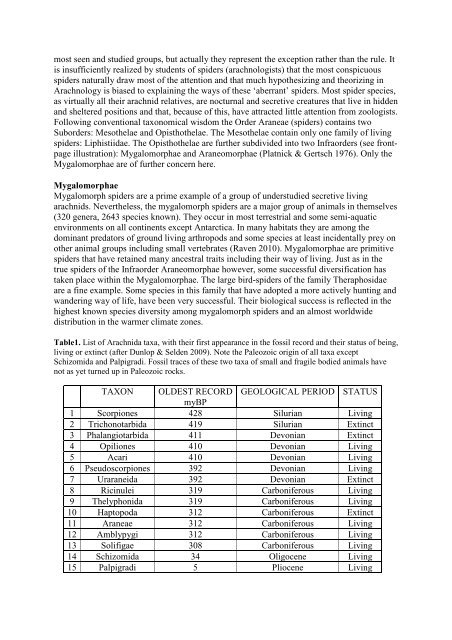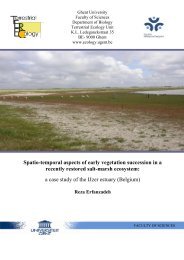PhD Arthur Decae 2010 - Ghent Ecology - Universiteit Gent
PhD Arthur Decae 2010 - Ghent Ecology - Universiteit Gent
PhD Arthur Decae 2010 - Ghent Ecology - Universiteit Gent
You also want an ePaper? Increase the reach of your titles
YUMPU automatically turns print PDFs into web optimized ePapers that Google loves.
most seen and studied groups, but actually they represent the exception rather than the rule. It<br />
is insufficiently realized by students of spiders (arachnologists) that the most conspicuous<br />
spiders naturally draw most of the attention and that much hypothesizing and theorizing in<br />
Arachnology is biased to explaining the ways of these ‘aberrant’ spiders. Most spider species,<br />
as virtually all their arachnid relatives, are nocturnal and secretive creatures that live in hidden<br />
and sheltered positions and that, because of this, have attracted little attention from zoologists.<br />
Following conventional taxonomical wisdom the Order Araneae (spiders) contains two<br />
Suborders: Mesothelae and Opisthothelae. The Mesothelae contain only one family of living<br />
spiders: Liphistiidae. The Opisthothelae are further subdivided into two Infraorders (see frontpage<br />
illustration): Mygalomorphae and Araneomorphae (Platnick & Gertsch 1976). Only the<br />
Mygalomorphae are of further concern here.<br />
Mygalomorphae<br />
Mygalomorph spiders are a prime example of a group of understudied secretive living<br />
arachnids. Nevertheless, the mygalomorph spiders are a major group of animals in themselves<br />
(320 genera, 2643 species known). They occur in most terrestrial and some semi-aquatic<br />
environments on all continents except Antarctica. In many habitats they are among the<br />
dominant predators of ground living arthropods and some species at least incidentally prey on<br />
other animal groups including small vertebrates (Raven <strong>2010</strong>). Mygalomorphae are primitive<br />
spiders that have retained many ancestral traits including their way of living. Just as in the<br />
true spiders of the Infraorder Araneomorphae however, some successful diversification has<br />
taken place within the Mygalomorphae. The large bird-spiders of the family Theraphosidae<br />
are a fine example. Some species in this family that have adopted a more actively hunting and<br />
wandering way of life, have been very successful. Their biological success is reflected in the<br />
highest known species diversity among mygalomorph spiders and an almost worldwide<br />
distribution in the warmer climate zones.<br />
Table1. List of Arachnida taxa, with their first appearance in the fossil record and their status of being,<br />
living or extinct (after Dunlop & Selden 2009). Note the Paleozoic origin of all taxa except<br />
Schizomida and Palpigradi. Fossil traces of these two taxa of small and fragile bodied animals have<br />
not as yet turned up in Paleozoic rocks.<br />
TAXON OLDEST RECORD GEOLOGICAL PERIOD STATUS<br />
myBP<br />
1 Scorpiones 428 Silurian Living<br />
2 Trichonotarbida 419 Silurian Extinct<br />
3 Phalangiotarbida 411 Devonian Extinct<br />
4 Opiliones 410 Devonian Living<br />
5 Acari 410 Devonian Living<br />
6 Pseudoscorpiones 392 Devonian Living<br />
7 Uraraneida 392 Devonian Extinct<br />
8 Ricinulei 319 Carboniferous Living<br />
9 Thelyphonida 319 Carboniferous Living<br />
10 Haptopoda 312 Carboniferous Extinct<br />
11 Araneae 312 Carboniferous Living<br />
12 Amblypygi 312 Carboniferous Living<br />
13 Solifigae 308 Carboniferous Living<br />
14 Schizomida 34 Oligocene Living<br />
15 Palpigradi 5 Pliocene Living










